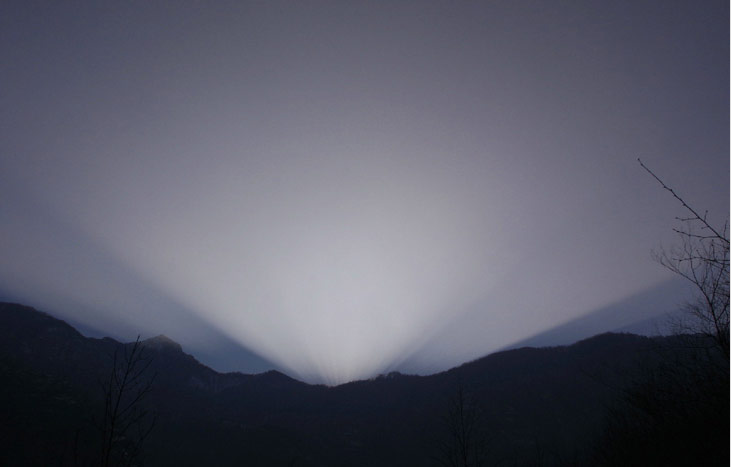Anti-crepuscular rays
Exploring the Enigmatic Phenomenon of Anti-Crepuscular Rays
When it comes to atmospheric optics, there are numerous fascinating phenomena that can captivate our imagination. One such phenomenon is the occurrence of anti-crepuscular rays. While many people are familiar with the awe-inspiring beauty of crepuscular rays, which are commonly seen at sunrise or sunset, anti-crepuscular rays offer a captivating counterpoint to this celestial spectacle.
What are Anti-Crepuscular Rays?
Anti-crepuscular rays, also known as antisolar rays, are a mesmerizing optical illusion that appears to radiate from the point in the sky opposite to the sun. Similar to their crepuscular counterparts, these rays are not physical entities but rather shafts of sunlight that are scattered and obscured by atmospheric particles such as dust, water droplets, or ice crystals.
The Illusion of Convergence
One of the most intriguing aspects of anti-crepuscular rays is their apparent convergence at a point on the horizon opposite to the sun. This convergence creates a mesmerizing effect where the rays seem to converge towards a vanishing point, giving observers a sense of depth and perspective. However, it is important to note that this convergence is merely an optical illusion caused by the projection of parallel rays onto the curved surface of the Earth.
Atmospheric Conditions and Viewing Opportunities
Like crepuscular rays, anti-crepuscular rays are most commonly observed during sunrise or sunset when the sun is low on the horizon. However, they are not limited to these times and can occasionally be seen during other parts of the day, depending on the atmospheric conditions and the position of the observer. To witness this captivating phenomenon, it is necessary to have a clear view of the horizon opposite to the sun, free from obstructions such as buildings or mountains.
The Role of Perspective
The visual impact of anti-crepuscular rays is heavily influenced by perspective. Observers who are positioned at a higher elevation, such as on a mountain or hilltop, may have a more dramatic view of the converging rays. This is because the elevated vantage point allows for a clearer line of sight and a broader expanse of the sky to observe the rays. As a result, anti-crepuscular rays can be at their most stunning in mountainous regions, where the interplay between light and terrain creates a breathtaking spectacle.
Similarities and Differences with Crepuscular Rays
While anti-crepuscular rays and crepuscular rays share some similarities, they also have distinct characteristics that set them apart. Both phenomena are caused by the scattering and diffusion of sunlight by atmospheric particles. However, crepuscular rays appear to radiate from the sun itself, while anti-crepuscular rays seem to converge towards the point opposite to the sun. Additionally, crepuscular rays are more commonly observed due to their visibility during sunrise and sunset, while anti-crepuscular rays are relatively rarer.
The Influence of Atmospheric Particles
The presence of atmospheric particles plays a crucial role in the formation and visibility of anti-crepuscular rays. These particles, such as dust, water droplets, or ice crystals, scatter and redirect sunlight, creating the distinct ray-like patterns that we observe. The size and composition of these particles determine the color and intensity of the rays. For instance, larger particles tend to scatter shorter-wavelength blue light more effectively, resulting in bluish hues in the rays.
Capturing the Beauty of Anti-Crepuscular Rays
Photographing anti-crepuscular rays can be a rewarding challenge for photographers. To capture the full splendor of this phenomenon, it is essential to choose an appropriate vantage point that offers an unobstructed view of the horizon opposite to the sun. The use of a wide-angle lens can help capture the expansive nature of the converging rays, while adjusting the exposure settings can enhance the contrast and vibrancy of the scene. Patience and timing are key, as the optimal conditions for observing and photographing anti-crepuscular rays may be fleeting.
A Mystical Display of Nature's Artistry
Anti-crepuscular rays serve as a reminder of the captivating and mysterious nature of atmospheric optics. These elusive beams of sunlight offer a mesmerizing display of nature's artistry, as they converge towards a point on the horizon opposite to the sun. Whether witnessed from a mountaintop or captured through the lens of a camera, the beauty of anti-crepuscular rays leaves observers in awe of the enchanting wonders that unfold in the skies above us. So, keep your eyes peeled during sunrise or sunset, and you may be fortunate enough to witness this celestial spectacle firsthand.

Anti-crepuscular rays, Valle di Riofreddo near Arsiero, Vicenza, Italy. Imaged 28th January 2003 by Pierluca Grotto. The rays can be at their most stunning in mountains. @2003 Pierluca Grotto, shown with permission.
Note: this article has been automatically converted from the old site and may not appear as intended. You can find the original article here.
Reference Atmospheric Optics
If you use any of the definitions, information, or data presented on Atmospheric Optics, please copy the link or reference below to properly credit us as the reference source. Thank you!
-
<a href="https://atoptics.co.uk/blog/anti-crepuscular-rays-7/">Anti-crepuscular rays</a>
-
"Anti-crepuscular rays". Atmospheric Optics. Accessed on April 18, 2024. https://atoptics.co.uk/blog/anti-crepuscular-rays-7/.
-
"Anti-crepuscular rays". Atmospheric Optics, https://atoptics.co.uk/blog/anti-crepuscular-rays-7/. Accessed 18 April, 2024
-
Anti-crepuscular rays. Atmospheric Optics. Retrieved from https://atoptics.co.uk/blog/anti-crepuscular-rays-7/.